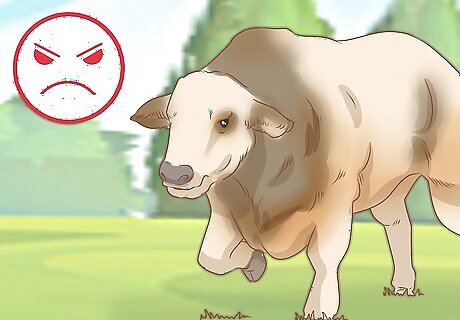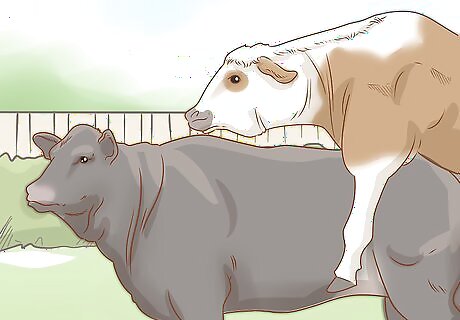
views
Recognizing the Physical Characteristics of Simmental Cattle

Note Simmental cattle’s weight and size. Simmental cattle are quite large, and notably rugged in physical composition. They have a heavy bone structure, with visibly strong feet and legs. Mature Simmental cows will weigh from 1,100 to 1,500 pounds or more. Mature Simmental bulls, which will show more muscle mass over their shoulders and hindquarters, usually weigh somewhere between 2,200 and 2,800 pounds. Simmental can gain weight particularly rapidly, increasing in weight by four to five pounds per day when in a favorable environment and well fed.

Identify Simmental body types. While all Simmental are noticeably blockish, they are not as rectangular as some other breeds, such as Limousins. Simmental cattle tend to have more loose dewlap – the skin that hangs beneath their chin and their underside – than many other common types of cattle. Use the identification of an especially pendulous dewlap to distinguish Simmental from other breeds that are also often black, such as Charolais, Gelbviehs, Maine Anjou, Salers, and Limousins. Simmental cows tend to have a larger udder than most other cattle breeds - though Holstein have recognizably larger udders. Simmental cow udders will have prominent forward and rear attachments to the underside of the cow, with equal-sized quarters and small, uniform teats that are evenly spaced.

Check for common Simmental head characteristics. On all Simmental, the head will be longer and larger than many similar breeds. They have particularly larger ears, which protrude from a low location on their head. Simmental cows have noticeably angular and feminine-looking heads, necks, and shoulders. Simmental bulls have curly hair on their foreheads, some more noticeably than others. Simmental bulls may be horned or polled, the latter being more common. If horns are present, they will be quite short, and point out and upward. Simmental lips and mouths are relatively trim and refined-looking as compared to other breeds, especially in comparison to Herefords.
Spotting Simmental Cattle Colorations

Recognize general Simmental coloration. Most Simmental cattle have a white face with a brownish-red body. Other Simmental cattle will be lighter in color, while some will be all black, and others mostly brown or mostly red. Some that are otherwise all black or all red will have a white face. In the U.S., where certain traits have continuously been selected for, Simmental are characterized by a wider range of color patterns. While American Simmental are mostly black, they may actually be any color or color pattern – from all black, to spotted or patchy, to all white. European Simmental are red or yellow with lots of white. All Simmental start life as greyish calves with shades of red and yellow hair. Pigmentation around the eyes, as well as the udder and scrotum, are common, especially in the U.S. Nearly all Simmental cattle will have ears that are the same color as their body.

Identify Fleckvieh-Simmental cattle. Flechvieh-Simmental cattle will range in color from a light buckskin-yellow to a brownish-red. They will have a white face that almost always has a border line just before the jawline, and a white underbelly. Some may have a patch over each eye; others may have one patch over one eye. White will likely show on the flank and elbows, sometimes forming a stripe from behind the elbows or from the flank all the way up to the topline. They will have a lot of white on their belly and legs. The tail of a Simmental-Fleckvieh will usually be all white or white half-way down. Simmental cattle do not have a white stripe down the nape of their necks, nor white dewlaps. If these are present, the cattle are likely Hereford.

Recognize modern Simmental cattle. Some more modern breeds of Simmental will have less white markings and will be mostly darker brownish-red to black. If they do have some white, it will likely be lower on the leg. White faces are common in modern Simmental, though they may have different colored eye patches and less white overall. Some Modern Simmental cattle may still have a recognizable white stripe from the shoulder down to the elbows, or from the top of the loins to the flanks.

Identify Fullblood or Straightbred Simmental cattle. These will likely be all black, all red, black and white, or mostly black or red but with a white or mostly-white face. Fullbloods are often bred with Red Angus, Angus or Hereford cattle. Simmental bulls that have been crossed with Angus and Red Angus breeds will often look like Angus at first glance. Distinguish Simmental from Angus cattle by noting ear and dewlap coloration, as well as muscularity, to decipher key differences between an Angus bull and a Black Simmental bull.
Monitoring Temperamental Characteristics

Monitor the cattle’s behavior. Simmental cattle tend to be docile and even-tempered, as these traits have long been selected for by breeders. Since Simmental are often bred for environments in which they are heavily managed by humans, they are noticeably calm.

Recognize early sexual maturity in Simmental cattle. Though it takes about four years to reach full size, Simmental cattle are known for experiencing early sexual maturity. Cows begin menstruation when they’re only 650-700 pounds, or as early as 9-12 months old. Bulls reach sexual maturity by 15 months of age and will readily breed with 25 cows in one season. Mature bulls will happily breed with about 50 cows in a seasons if environment permits.

Check for Simmental’s particularly maternal behaviors. Simmental cows' docility and high milk production allow for roughly annual births. A Simmental cow will maintain a yearly calving cycle for as many as a dozen years. Cows can conceive as young as 15 months old. Simmental cows will happily breed while nursing.




















Comments
0 comment